In the earlier post Ukraine 2005 I briefly described my trip to Ukraine to drive Russian-built steam locomotives. After a long interval, I'll take up the story.
Ukraine has an extensive railway system to the Russian gauge of 5 feet and, although Ukraine has been a sovereign state since 1991, the railway infrastructure and rolling stock was principally provided by Russia during the Soviet era.
Click here for a railway map of Ukraine.
The visit was arranged by East Europe Railtours Limited in the U.K. and Dzherelo SPK in Ukraine. On 22nd October 2005, we arrived by air in Kiev, the capital of Ukraine, and met up with the other members of the group. In total, there were twelve of us. We travelled overnight by train on the overhead electrified line west to L'viv (Lvov in Russian) which is fairly near the Polish border. After changing engines, we continued south to Ivano Francovsk on the non-electrified line, arriving in the morning.
 The station buildings at Ivano-Frankovsk viewed from the road side.
The station buildings at Ivano-Frankovsk viewed from the road side.
From Ivano Francovsk, a coach took us further south to Kolomiya and the Hotel Pysanka which would be the base for our engine driving activities. 'Pysanka' is the word for the decorated eggs typical of the area. Just outside the hotel was the Pysanka Museum ('Egg Museum') displaying a range of decorated eggs. The central building of the museum was egg-shaped, so this provided a useful landmark when exploring the town.
 The group outside the hotel in Kolomiya.
The group outside the hotel in Kolomiya.
Railways around Kolomiya
Kolomiya is an important railway junction. The railway from Ivano Francovsk to Chernivtsi passes through Kolomiya and two branches radiate. The branch to the south-west passes through some beautiful country in the Carpathians to Rakhov, and then over the border into Romania. The other branch heads broadly north-east to Stefaneshty.
Railways around Kolomiya.
Kolomiya Steam Shed
Having checked-in at our hotel, we were taken to the steam shed for a briefing and the opportunity to look at the locomotives. The motive power depot at Kolomiya had a roundhouse with steam locomotives. Nearby, there was a straight shed (which we didn't visit) for diesel locomotives.
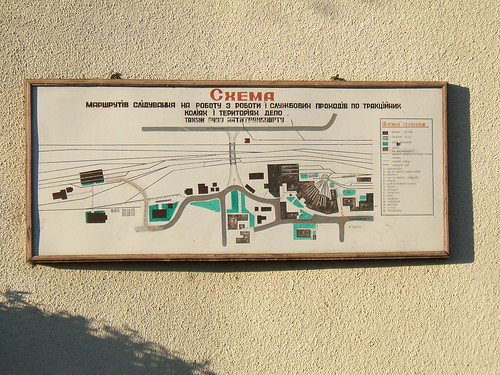 Plan of the motive power depot displayed at Kolomiya depot.
Plan of the motive power depot displayed at Kolomiya depot.
The following steam locomotives were 'on shed':-
Em 735-72The 'Em' and 'Er' were sub-classes of the ubiquitous 0-10-0 freight locomotives which were produced in large numbers. There's a brief profile here.
Er 797-86
Yea 2026
b 2137
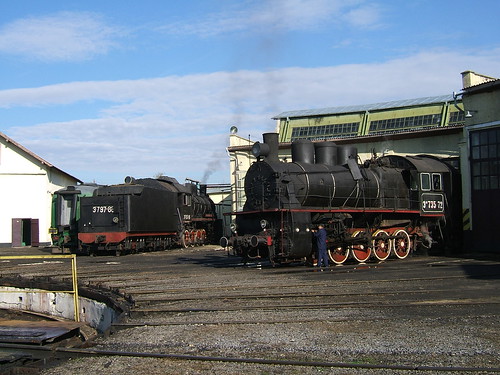 Er 797-86/Em 735-72 at Kolomiya depot.
Er 797-86/Em 735-72 at Kolomiya depot.
The 'Yea' was an American design imported in both the First and Second World Wars. There's a brief profile of this class here. We found Yea 2026 inside the shed at Kolomiya, with smokebox door open, as the fitters were still completing the replacement of leaking smoke tubes.
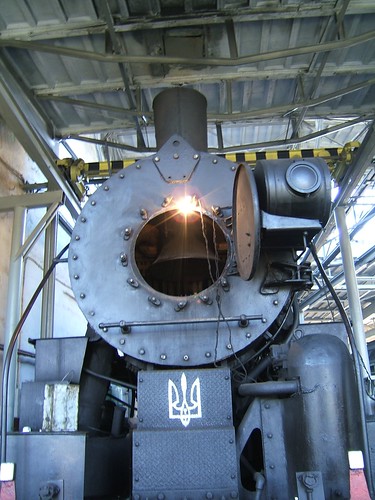
Yea 2026 inside the shed at Kolomiya, with smokebox door open.
The 'b' class was a four-coupled side tank but this was not steamed during our stay. I think the '1885' on the side tank commemorates the year the first railway opened at Kolomiya.
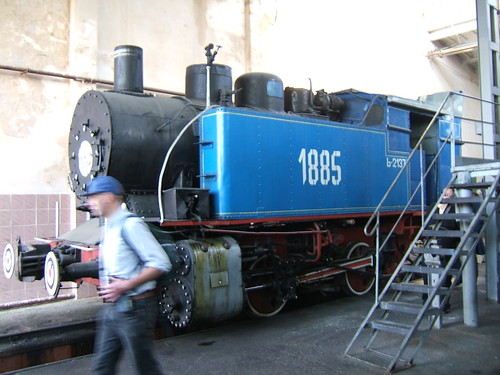 B 2137 inside the shed at Kolomiya.
B 2137 inside the shed at Kolomiya.
Leter in the day, an 'Su' class (Su 251-86) arrived light engine under its own power from her home depot, Chernivtsi, to add to the 'stud'. She brought two rather battered Engineer's Coaches.
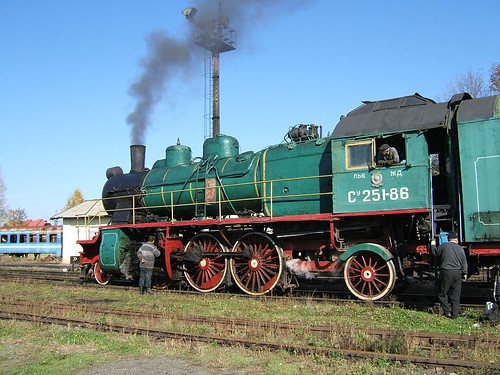 Su 251-86 on arrival at Kolomiya from Chernivtsi.
Su 251-86 on arrival at Kolomiya from Chernivtsi.
We spent most of the day around the shed studying the locomotives and looking at the activity around the station, with diesel traction like the 2M62 (a 2-section Co-Co) on freight trains and 4-car Diesel Multiple Units like the D1 on passenger trains.
 2M62-0888 with a freight at Kolomiya.
2M62-0888 with a freight at Kolomiya.
 Diesel Multiple Unit D1-552-3 stabled near the Roundhouse at Kolomiya.
Diesel Multiple Unit D1-552-3 stabled near the Roundhouse at Kolomiya.
The following day the driving commenced, as described in Driving Steam in Ukraine (Part 2).
Russian Railway background
At the time of my visit in 2005, I was almost completely ignorant about Russian Railway practice. The book 'Soviet Locomotive Types - The Union Legacy' (reference [1] below) is an invaluable primer on Russian steam, diesel and electric traction. In 2011, a river cruise from Moscow to St. Petersburg (described in a series of posts here) gave me tantalising glimpses of railways in Russia. Then, in 2011, I travelled by the 'Golden Eagle' private train from Ulaan Baatar to Moscow (described in a series of posts here).
Book References
[1] 'Soviet Locomotive Types - The Union Legacy' by A J Heywood & I D C Button (Frank Stenvalls Forlag) ISBN 0-9525202-0-6.
My pictures
Ukraine Steam.
Ukraine Modern Image.
